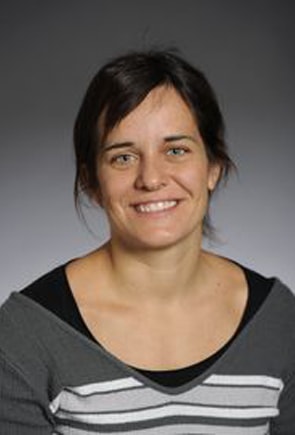Tiziana Di Matteo
Professor of Physics
Director, McWilliams Center for Cosmology & Astrophysics
Astrophysics & Cosmology
Wean Hall 8305
412-268-1888

Education & Professional Experience
Ph.D.: University of Cambridge (U.K.), Astrophysics (1998)
B.Sc.: University College London (U.K), Astrophysics (1995)
Professional Societies:
Fellow, American Physical Society
Honors and Awards:
Carnegie Science Award of Excellence (2008)
Berkham Faculty Grant (2006)
Michael Penston Prize of the Royal Astronomical Society (1999)
Director, McWilliams Center for Cosmology & Astrophysics, Carnegie Mellon University, 2020–
Professor of Physics, Carnegie Mellon University, 2014–
Indefinite Tenure, Carnegie Mellon University, 2009
Associate Professor, Carnegie Mellon University, 2005–2014
Associate Professor, The Max-Planck Institute for Astrophysics, Garching, 2003–05
Research Associate, The Max-Planck Institute for Astrophysics, Garching (Germany), 2001–03
Post-doctoral Research (Astrophysics): Harvard University, 1998–2001
Research Interests
It is now well-established that black holes are an important feature of our cosmic environment. Stellar-mass black holes number in the millions in every galaxy; there is now conclusive evidence that black holes as massive as a billion suns reside at the centers of most galaxies. Black holes are thought to power the most energetic phenomena in the Universe from quasars to, perhaps even Gamma-Ray-Bursts. My research interests focus on studies of black holes encompassing a wide range of topics in both High Energy Astrophysics and Cosmology. They include theoretical studies of the interplay between black hole growth and galaxy formation and investigations of various aspects of the physics of accretion disks around black holes.
Cosmological simulations of black hole formation: I am currently involved in developing a new prescription in the context of hydrodynamical simulations of galaxy formation which, together with star formation and supernovae feedback, follows black hole accretion and its associated feedback in the center of galaxies. This is a novel attempt within models of galaxy formation to track self-consistently the growth of supermassive black holes and the evolution of the galaxy itself. Galaxy formation and black hole growth are mutually intertwined processes, requiring joint theoretical modeling to be meaningfully addressed.
21-cm tomography and foregrounds: An exciting future probe of the epoch of reionization will be 21-cm tomography of the neutral hydrogen in the Intergalactic medium and in gravitationally collapsed systems. I have been modeling the contaminating foreground radiation to the primary 21-cm radiation due to galaxies which produce radio emission and free-free emission and extended sources include radio halos and relics. We are using cosmological simulations and are producing simulated sky maps for the upcoming Lofar and PAST facilities.
Neutrino transport around black holes and Gamma-Ray Bursts: In recent years the exciting field of Gamma-Ray Bursts has opened up to the studies of black hole accretion. Rapid, hyper-Eddington accretion is likely to power the central engines of Gamma-Ray Bursts. In these extreme conditions of densities and temperatures the accreting material is cooled by neutrino emission rather than by radiation. I have been working on deriving dynamical solutions for neutrino dominated accretion flows.
Accretion models and X-rays: Accretion of matter onto a black hole is able to liberate large amounts of its binding energy. By studying the power output from accretion disks, we are able to probe the deep gravitational potentials around black holes. Nearby black holes however, are much less luminous than active galactic nuclei in distant galaxies. I build models for the emission from nearby black holes using Chandra Satellite and XMM-Newton observations.
Recent Publications
Aklant K. Bhowmick et al., The evolution of galaxy intrinsic alignments in the MassiveBlackII universe, MNRAS 491, 4116 (2020)
S. Samuroff, R. Mandelbaum, T. Di Matteo, Testing the impact of satellite anisotropy on large- and small-scale intrinsic alignments using hydrodynamical simulations, MNRAS 491, 5330 (2020)
Ananth Tenneti et al., A tiny host galaxy for the first giant black hole: z = 7.5 quasar in BlueTides, MNRAS 483, 1388 (2019)
Kayhan Gültekin et al., The Fundamental Plane of Black Hole Accretion and Its Use as a Black Hole-Mass Estimator, Astrophys. J. 871, 80 (2019)
Tiziana Di Matteo, Black Holes Across Cosmic History: A Journey Through 13.8 Billion Years, Saas-Fee Advanced Course, Springer (2019)
Y. Ni, M.-Y. Wang, Y. Feng, T. Di Matteo, Predictions for the abundance of high-redshift galaxies in a fuzzy dark matter universe, MNRAS 488, 5551 (2019)
A.K. Bhowmick, T. Di Matteo, S. Eftekharzadeh, A.D. Myers, On the small-scale clustering of quasars: constraints from the MassiveBlack II simulation, MNRAS 485, 2026 (2019)
Kuan-Wei Huang et al., BlueTides simulation: establishing black hole−galaxy relations at high redshift, MNRAS 478, 5063 (2018)
Ananth Tenneti et al., The radial acceleration relation in disc galaxies in the MassiveBlack-II simulation, MNRAS 474, 3125 (2018)
Stephen M. Wilkins et al., The properties of the first galaxies in the BlueTides simulation, MNRAS 469, 2517 (2017)
M.S. Liu, T. Di Matteo, Y. Feng, The effects of AGN feedback and SPH formulation on black hole growth in galaxies, MNRAS 458, 1402 (2016)
S.M. Wilkins, Y. Feng, T. Di Matteo, R. Croft, The Lyman-continuum photon production efficiency in the high-redshift Universe, MNRAS 458, L6 (2016)
More Publications:
ORCID Researcher ID